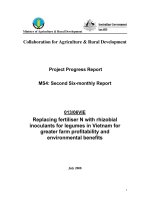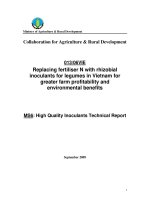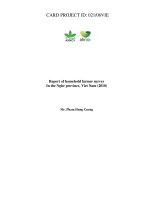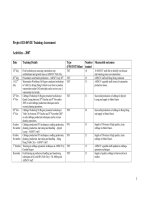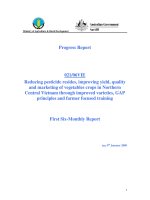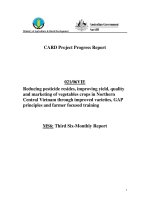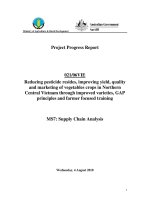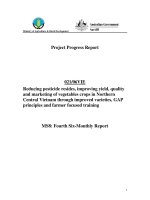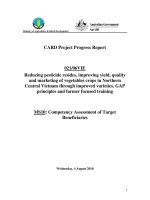Báo cáo khoa học nông nghiệp " Sustainable Community-Based Forest Development and Management in Some High Poverty Areas in Bac Kan Province ( Community Forest Management Plans )" pptx
Bạn đang xem bản rút gọn của tài liệu. Xem và tải ngay bản đầy đủ của tài liệu tại đây (172.21 KB, 29 trang )
MS4 ATTACHMENT 2
Ministry of Agriculture & Rural Development
Collaboration for Agriculture and Rural Development
Sustainable Community-Based Forest Development and
Management in Some High Poverty Areas in Bac Kan Province
(Project 017/06 VIE)
Community Forest Management Plans
Prepared by
Thai Nguyen University of Agriculture and Forestry
Kim Hy Nature Reserve
Bac Kan Extension Department
October 2007
2
Table of Contents
1. Introduction: 3
2. Objectives of CFM plan 3
2.1 Establish regulations of CFM 3
2.1.1 Regulations of CFM 3
CFM regulation should consider general conditions: 3
2.2.2 Contents of CFM regulations 3
2.2 CMF Plan 4
3. Methods 4
3.1 Working group 4
3.2 Methods for establishing forest protection regulations 4
3.3 Development of CFM plan 4
3.4 Summary and writing results: 5
4. Results 5
4.1 Establish CMF regulations 5
4.1.1 Regulations of Community Forests for To Dooc Village 6
4.1.2 Regulations of Community Forests for Khoa Lieng Village 9
4.1.3 Regulations of Community Forests for Ban Sang Village 12
4.1.4 Regulations of Community Forests for Na Muc Village 15
4.2 CFM plans 18
4.2.1 CFM plan for To Dooc village 18
4.2.2 Khuoi Lieng village 20
4.2.3 Ban Sang Village 22
4.2.4 Na Muc Village 24
5. Conclusions and recommendations 25
Appendix 1: Schedule for development of CFM plans 26
Appendix 1.1: To Dooc Village 26
Appendix 1.2: Khuoi Lieng Village 27
Appendix 1.3: Ban Sang 28
Appendix 1.4: Na Muc Village 29
3
1. Introduction:
CARD Project 017/06VIE - Sustainable community-based forest development and
management in some high poverty areas in Bac Kan Province" at the four pilot villages,
Na Muc and Khuoi Lieng village (Van Minh Commune) and To Dooc and Ban Sang (Lang
San Commune), Na Ri District, Bac Kan province has been implemented. The first stage as
land use planning and land allocation to village communities was completed which gave a
necessary condition to implement the CFM project. Following this step, developing CFM plan
is an important task to organise how the community forests will be managed and developed
by village communities to meet sustainability.
CFM plan should be developed with participation of all community members as they are
decision makers in the plan
A CFM plan includes regulations of CFM, a general plan and a detailed plan. Regulations of
CFM is a legal foundation for community members to implement CFM at the village level.
General and detailed plans will help the communities to implement project activities
following time table for the next several years such as plantation technique, fire prevention
and protection, logging, and processing. In addition, the plan can be used to seek funding
support from outside. More over, it can be used for evaluating results of the project in the
future.
To meet contents as above, CFM plans have been developed for implementation at the four
pilot villages of this CARD project.
2. Objectives of CFM plan
2.1 Establish regulations of CFM
2.1.1 Regulations of CFM
CFM regulation should consider general conditions:
- Within the jurisdiction of laws and appropriate with local traditional culture or
custom.
- Clearly stated and easy to understand and implement.
2.2.2 Contents of CFM regulations
- Rights and responsibilities of all community members in forest protection and
development
- Rules to protect forests and mobilise human resources to protect and develop forests
- Logging, buy and sell, timber and non-timber transport
- Forest animals
- Grazing animals in the community forest
- Prevent forest fire, methods to use fire in the forest
- Checking and preventing outsiders from shifting cultivation, illegal logging or
hunting, and illegal buying, selling and transporting timber/non-timber/animals
within the village.
- Cooperation among community members in forest protection/development,
production services and sale of products.
- Collaborating with other villages to protect and develop the forests effective
- Regulations on punishment for breaking the forest protection rules
4
- Regulations on sharing benefits within community members
- The regulations should be presented to all community member and the need to be
submit to Commune People's Committee for approval.
2.2 CMF Plan
A CFM plan covers general plan for forest management and an annual plan for
implementation.
Thus a CMF plan should include the following details:
- New plantation plan such as what kinds of species? how big area?, where? When?
How much of labor costs? How many seedlings? Sources of seedlings?
- Nursery plan, seedling production
- Maintenance and protection
- Harvesting plans
- Human resource plan
- Other activities such as agro-forestry
3. Methods
3.1 Working group
Working team in the field includes staffs from Thai Nguyen University, Bac Kan Extension
Department, Kim Hy Natural Reserve Area, extentionists from Van Minh and Lang San
communes, and key villagers. Mr. Nguyen My Hai (Bac Kan staff) has a main responsibility
for the fieldwork and preparing first draft report.
Thai Nguyen University staff provided advice, checking and writing final report.
3.2 Methods for establishing forest protection regulations
Structure of CFM regulation is prepared in advance, based on related legal documents and
local traditional culture and custom.
Group meetings were carried out for discussion and drawing regulations on community forest
protection and development. The last draft of the Community Forest Protection and
Development Regulations was presented and updated by the whole village community
through a village meeting. These regulations become formal documents after being accepted
by the majority of village members, and will become legal documents after being approved by
the local authorities (commune and district levels).
3.3 Development of CFM plan
To develop CFM plan, the following steps are taken:
Step 1- Field survey:
• Working group and all members of village community (one person from each
household) go to the field together. In the field, they need to find out:
• Review borders, forest types and farming systems of community forest areas.
• Discuss with villagers what should be done on the different forest types, including:
o Bare land - find out what kinds of species should be planted on the different
sites.
5
o Young forest types - decide what technical activities should be carried out for
maintenance and protection task.
• Discuss solutions how to reduce/stop shifting cultivation in community forests
• Discuss free grazing, forest fire and illegal timber logging or harvest of non-timber
products, and how to prevent these situations.
• Working group and villagers work together to estimate the amount of new plantation
seedlings and labor working days.
Step 2- Village meeting
The working group and key informants from the village will develop CFM plan (general and
detailed plans) based on data/information from the field surveys in Step 1). The CFM plan
should consider some main points as follows:
• Cropping seasons, priority for short-term and long-term purposes
• Short and clear so villagers can understand and contribute their ideas
• CFM plan should be presented and updated to all villagers through a village meeting.
It will become a formal CFM plan after being accepted by the majority of villagers at
the meeting.
3.4 Summary and writing results:
All data/information from the field surveys and results from group discussion /village meeting
should be summarized following table formats.
4. Results
4.1 Establish CFM regulations
Regulations of CFM for the four pilot villages have been developed with full
participation of villagers. The proposed regulations were subsequently accepted by all
members of the village communities through final village meetings.
Once these regulations receive approval by district People’s Committee, they will
become legal documents for the villages.
6
4.1.1 Regulations of Community Forests for To Dooc Village
A structure of CFM regulations consisting of 12 articles is based on:
(1) The related legal documents as:
- Documentation No. 56/1999/TT/BNN-KL dated 30/3/1999 on guidelines of Community
Forest Protection and Development Regulations.
- Degree No. 106/2006/BNN-PTNT on establishing and management community forests.
- Decree No. 139/2004/CP dated 25/6/2005 on Administration Treatment of Forest
Product protection and Management.
- Decree No. of Na Ri District Committee's People on Land Allocation to Village
Community
(2) Village Meeting dated 10 October 2007
Article 1: Rights and Responsibility of village community members on forest protection
and development:
- Rights: the community can obtain all benefits of timber and non-timber products from the
allocated community forests. However, all logging or harvesting must follow legal regulations
and ensure sustainability.
- Responsibilities: all members of the village community have a responsibility on forest
protection and development activities, in particular contribution of labour inputs for new
planting and maintenance of young forests.
Article 2: Shifting cultivation/upland fields
- Do not practice shifting cultivation or upland fields on the community forest areas.
- Only practice cultivation in the upland fields as designed in the LUP.
Article 3: Free grazing in the forests
- No free animal grazing in the community forest areas.
Article 4: Forest development
- Planting trees on all bare hills/plots which have been located in the community forest areas.
- Maintain and protect all existing regenerated forests.
Article 5: Forest protection and prevention of forest fire
- The village community has a responsibility in all tasks of forest protection and prevention of
forest fire.
- Establish forest patrol groups for prevention of illegal logging, forest fire, free grazing and
others.
Article 6: Human resources on forest protection and development
7
- All community members will contribute labour inputs for forest protection and development
activities.
Article 7: Community Forest Management Board
- Community Forest Management Board (5 people representing the village community
through voting) is elected every one or two years. This Board can be added or changed
where necessary.
- The Community Forest Management Board should have responsibilities for developing and
implementing the related activities in the CFM Plan such as mobilizing labour working days
for new plantation, logging, harvesting, and checking forests.
Article 8: Forest product logging/harvesting
- All timbers and non-timber products from the community forests belong to the village
community.
- To exploit a large quantity of timber and non-timber products from the community forests, a
permit must be obtained from the community, including when, where and how to meet all
legal regulations of forest product exploitation.
- Non-timber products such as honey bee, mushrooms and fruits can be collected as normal
practice by the community.
- If households within the village community need timber from the community forest areas for
house construction, they must obtain a permit from the community. In addition, they have to
pay a fee to the community. The amount of timber for logging and amount of fee will be
decided by the community.
- The Community Forest Management Board has a responsibility on management of
harvesting forest products from the community forests.
Article 9: Benefit sharing
Any income and benefit from the community forests will be shared as follows:
- 20% of total income for the forest development fund
- 20% of total income for community activities
- 60% of total income for households who contributed their work.
Article 10: Deal with illegal activities
- All illegal activities are subject to penalty and fine 3 times of the value of the damage.
- Illegal logging is strictly prohibited. Infringement is subject to penalty and fine 2.5 times
of the value of timber. In addition, all illegally exploited timbers will be confiscated by the
community.
- If animals from any household cause damage to the community forests, they have to pay
compensation to all damages.
- Other illegal activities which cause serious damage to the community forests will be
referred to the court.
Article 11: Other regulations
8
- Selling products from the community forests will be decided by the village community.
- When the village community harvest timbers from the community forests, members of the
village have the priority to buy the timber for their own use only at 5-10% discount.
- The Community Forest Management Board has a responsibility to coordinate with other
villages on forest protection with the support from the local authorities.
Article 12: Execution of article
- The regulations as above were accepted by the village community through the village
meeting and approved by the Commune People’s Committee.
- These regulations are effective from the approval date.
Representative of CFM Board Commune People’s Committee
District People’s Committee
9
4.1.2 Regulations of Community Forests for Khoa Lieng Village
A structure of CFM regulations consisting of 12 articles is based on:
(1) The related legal documents as:
- Documentation No. 56/1999/TT/BNN-KL dated 30/3/1999 on guidelines of Community
Forest Protection and Development Regulations.
- Degree No. 106/2006/BNN-PTNT on establishing and management community forests.
- Decree No. 139/2004/CP dated 25/6/2005 on Administration Treatment of Forest
Product protection and Management.
- Degree No. of Na Ri District Committee's People on Land Allocation to Village
Community
(2) Village Meeting dated 14 October 2007
Article 1: Rights and Responsibility of village community members on forest protection
and development:
- Rights: the community can obtain all benefits of timber and non-timber products from the
allocated community forests. However, all logging or harvesting must follow legal regulations
and ensure sustainability.
- Responsibilities: all members of the village community have a responsibility on forest
protection and development activities, in particular contribution of labour inputs for new
planting and maintenance of young forests.
Article 2: Shifting cultivation/upland fields
- Reduce or stop practicing shifting cultivation in the community forest areas.
- For households who are currently practicing upland fields in the community forests, they
can continue with a maximum area of 0.5 ha. All areas above 0.5 ha should be handed back
to the community for forest management. All shifting cultivation must be stopped within 3
years and the land given back to the community for establishment of new plantation.
Article 3: Free grazing in the forests
- No free animal grazing in the community forest areas.
Article 4: Forest development
- Planting trees on all bare hills/plots which are located within the community forest areas.
- Maintain and protect all existing regenerated forests.
Article 5: Forest protection and prevention of forest fire
- The village community has a responsibility on all tasks of forest protection and prevention
of forest fire.
- Establish forest patrol groups to prevent illegal logging, forest fire, free grazing and others.
10
Article 6: Human resources on forest protection and development
- All community members will contribute labour inputs for forest protection and development
activities.
Article 7: Community Forest Management Board
- Community Forest Management Board (5 people representing the village community
through voting) is elected every one or two years. This Board can be added or changed
where necessary.
- The Community Forest Management Board has a responsibility for developing and
implementing plan related to CFM activities such as mobilizing labour working days for
new plantation, logging, harvesting, checking forests.
Article 8: Forest product logging/harvesting
- All timbers and non-timber products which are collected from the community forests belong
to the village community.
- To exploit a large amount of timber and non-timber products from the community forests, a
permitted must be obtained from the community, including when, where and how to meet
all legal regulations of forest product exploitation.
- Non-timber products such as honey bee, mushrooms and fruits can be collected as usual by
the community.
- If households within the village community need timber from the community forest areas for
building their house, they need to obtain permission from the community. In addition, they
have to pay a fee to the community. The amount of timber for logging and fee will be
decided by the community.
- The Community Forest Management Board has a responsibility on management of forest
product harvesting from the community forests.
Article 9: Benefits sharing
Any income from the community forests will be shared as below:
- 20% of total income for the forest development fund
- 20% of total income for community activities
- 60% of total income for households who contributed their work
Article 10: Deal with illegal activities
- All illegal activities are subject to penalty and fine 3 times of the value of the damage.
- Illegal logging is strictly prohibited. Infringement is subject to penalty and fine 2.5 times
of the value of timber. In addition, all illegally exploited timbers will be confiscated by the
community.
- If animals from any household cause damage to the community forests, they have to pay
compensation to all damages.
- Other illegal activities which cause serious damage to the community forests will be
referred to the court.
11
Article 11: Other regulations
- Selling products from the community forests will be decided by the village community.
- When the village community harvest timbers from the community forests, members of the
village have the priority to buy the timber for their own use only at 5-10% discount.
- The Community Forest Management Board has a responsibility to coordinate with other
villages on forest protection with the support from the local authorities.
Article 12: Execute article
- The regulations as above were accepted by the village community through the village
meeting and approved by the Commune People’s Committee.
- These regulations are effective from the approval date.
Representative of CFM Board Commune People’s Committee
District People’s Committee
12
4.1.3 Regulations of Community Forests for Ban Sang Village
A structure of CFM regulations consisting of 12 articles is based on:
(1) The related legal documents as:
- Documentation No. 56/1999/TT/BNN-KL dated 30/3/1999 on guidelines of Community
Forest Protection and Development Regulations.
- Degree No. 106/2006/BNN-PTNT on establishing and management community forests.
- Decree No. 139/2004/CP dated 25/6/2005 on Administration Treatment of Forest
Product protection and Management.
- Degree No. of Na Ri District Committee's People on Land Allocation to Village
Community
(2) Village Meeting dated 10 October 2007
Article 1: Rights and Responsibility of village community members on forest protection
and development:
- Rights: the community can obtain all benefits of timber and non-timber products from the
allocated community forests. However, all logging or harvesting must follow legal
regulations and ensure sustainability.
- Responsibilities: all members of the village community have a responsibility on forest
protection and development activities, in particular contribution of labour inputs for new
planting and maintenance of young forests.
Article 2: Shifting cultivation/upland fields
- Do not practice shifting cultivation or cultivation in upland fields on the community forest
areas.
- Only practicing upland fields as designed by the LUP.
Article 3: Free grazing in the forests
- No free animal grazing in the community forest areas.
Article 4: Forest development
- Planting trees on all bare hills/plots which are located in the community forest areas.
- Take care and protect all existing regenerated forests.
Article 5: Forest protection and prevention of forest fire
- The village community has a responsibility on all tasks of forest protection and prevention
of forest fires.
- Establish forest patrol groups to prevent illegal logging, forest fires, free grazing and others.
Article 6: Human resources on forest protection and development
13
- All community members will contribute labour inputs for forest protection and development
activities.
Article 7: Community Forest Management Board
- Community Forest Management Board (5 people representing the village community
through voting) is elected every one or two years. This Board can be added or changed
where necessary.
- The Community Forest Management Board has a responsibility for developing and
implementing plan related to CFM activities such as mobilizing labour working days for
new plantation, logging, harvesting, checking forests.
Article 8: Forest product logging/harvesting
- All timbers and non-timber products which are collected from the community forests belong
to the village community.
- To exploit a large amount of timber and non-timber products from the community forests, a
permitted must be obtained from the community, including when, where and how to meet
all legal regulations of forest product exploitation.
- Non-timber products such as honey bee, mushrooms and fruits can be collected as usual by
the community.
- If households within the village community need timber from the community forest areas for
building their house, they need to obtain permission from the community. In addition, they
have to pay a fee to the community. The amount of timber for logging and fee will be
decided by the community.
- The Community Forest Management Board has a responsibility on management of forest
product harvesting from the community forests.
Article 9: Sharing benefits
Any income from the community forests will be shared as below:
- 20% of total income for the forest development fund
- 20% of total income for community activities
- 60% of total income for households who contributed their work
Article 10: Deal with illegal activities
- Sabotaged activities are subject to penalty and fine 3 times of the damage value.
- Illegal logging is strictly prohibited. Infringement is subject to penalty and fine 2.5 times
of the value of timber. In addition, all illegally exploited timbers will be confiscated by the
community.
- If animals from any household cause damages to the community forests, they have to pay
compensation, 1 time the damaged value on the first time, 2 times the damaged value on
second time, and 3 times the damaged value on third time, and so on.
- Other illegal activities which cause serious damage for the community forests will be
referred to the court.
14
Article 11: Other regulations
- Selling products from the community forests will be decided by the village community.
- When the village community harvest timbers from the community forests, members of the
village have the priority to buy the timber for their own use only at 5-10% discount.
- The Community Forest Management Board has a responsibility to coordinate with other
villages on forest protection with the support from the local authorities.
Article 12: Execute article
- The regulations as above were accepted by the village community through the village
meeting and approved by the Commune People’s Committee.
- These regulations are effective from the approval date.
Representative of CFM Board Commune People’s Committee
District People’s Committee
15
4.1.4 Regulations of Community Forests for Na Muc Village
A structure of CFM regulations consisting of 12 articles is based on:
(1) The related legal documents as:
- Documentation No. 56/1999/TT/BNN-KL dated 30/3/1999 on guidelines of Community
Forest Protection and Development Regulations.
- Degree No. 106/2006/BNN-PTNT on establishing and management community forests.
- Decree No. 139/2004/CP dated 25/6/2005 on Administration Treatment of Forest
Product protection and Management.
- Degree No. of Na Ri District Committee's People on Land Allocation to Village
Community
(2) Village Meeting dated 14 October 2007
Article 1: Rights and Responsibility of village community members on forest protection
and development:
- Rights: the community can obtain all benefits of timber and non-timber products from the
allocated community forests. However, all logging or harvesting must follow legal
regulations and ensure sustainability.
- Responsibilities: all members of the village community have a responsibility on forest
protection and development activities, in particular contribution of labour inputs for new
planting and maintenance of young forests.
Article 2: Shifting cultivation/upland fields
- Do not practice shifting cultivation or cultivation in upland fields on the community forest
areas.
- Only practicing upland fields as designed by the LUP.
Article 3: Free grazing in the forests
- No free animal grazing in the community forest areas.
- Planting trees on all bare hills/plots which are located in the community forest areas.
- Take care and protect all existing regenerated forests.
Article 5: Forest protection and prevention of forest fire
- The village community has a responsibility on all tasks of forest protection and prevention
of forest fires.
- Establish forest patrol groups to prevent illegal logging, forest fires, free grazing and others.
Article 6: Human resources on forest protection and development
16
- All community members will contribute labour inputs for forest protection and development
activities.
Article 7: Community Forest Management Board
- Community Forest Management Board (5 people representing the village community
through voting) is elected every one or two years. This Board can be added or changed
where necessary.
- The Community Forest Management Board has a responsibility for developing and
implementing plan related to CFM activities such as mobilizing labour working days for
new plantation, logging, harvesting, checking forests.
Article 8: Forest product logging/harvesting
- All timbers and non-timber products which are collected from the community forests belong
to the village community.
- To exploit a large amount of timber and non-timber products from the community forests, a
permitted must be obtained from the community, including when, where and how to meet
all legal regulations of forest product exploitation.
- Non-timber products such as honey bee, mushrooms and fruits can be collected as usual by
the community.
- If households within the village community need timber from the community forest areas for
building their house, they need to obtain permission from the community. In addition, they
have to pay a fee to the community. The amount of timber for logging and fee will be
decided by the community.
- The Community Forest Management Board has a responsibility on management of forest
product harvesting from the community forests.
Article 9: Sharing benefits
Any income from the community forests will be shared as below:
- 20% of total income for the forest development fund
- 20% of total income for community activities
- 60% of total income for households who contributed their work
Article 10: Deal with illegal activities
- Sabotaged activities are subject to penalty and fine 3 times of the damage value.
- Illegal logging is strictly prohibited. Infringement is subject to penalty and fine 2.5 times of
the value of timber. In addition, all illegally exploited timbers will be confiscated by the
community.
- If animals from any household cause damages to the community forests, they have to pay
full compensation to cover the damage.
- Other illegal activities which cause serious damage for the community forests will be
referred to the court.
17
Article 11: Other regulations
- Selling products from the community forests will be decided by the village community.
- When the village community harvest timbers from the community forests, members of the
village have the priority to buy the timber for their own use only at 5-10% discount.
- The Community Forest Management Board has a responsibility to coordinate with other
villages on forest protection with the support from the local authorities.
Article 12: Execute article
- The regulations as above were accepted by the village community through the village
meeting and approved by the Commune People’s Committee.
- These regulations are effective from the approval date.
Representative of CFM Board Commune People’s Committee
District People’s Committee
18
4.2 CFM plans
All general and annual plans of four pilot villages have ben developed and accepted by the
whole community through village meetings. The detail CFM plan in each village is presented
in the following sections.
4.2.1 To Dooc village
General CFM Plan
No Contents Quantity Year for
implementation
Responsibility
1 New plantation 20 ha 2008- 2012 All villagers
2 Building nursery 15,000 seedlings 2008- 2012 All villagers
3 Agro-forestry model
1 ha 2008 All villagers
4 Take care and
protection
40 ha from 2007 "
5 Establish forest
patrol group
1 group On going 4-5 people
6 Take care new
plantation
20 ha On going All villagers
7 Develop community
forest fund
1 From 2007 and
continuing
All villagers
8 Harvest forest
products if available
Follow harvesting
season
All Villagers
9 Technical training
courses
Following the project plan and planting/harvesting/processing seasons
Annual CFM Plan
No.
Activity Quantity Time implementation Responsibility
Year 2007- 2008
1 Establish nursery 50,000 seedlings (25,000 acacia; 25,000
manglietia)
Village
community
- building nursery 60 labour days 10/2007 ''
- fill plastic bags 60 labour days 10-11/07 ''
- sow seed/seedlings 15 labour days 11/08, 1/08 ''
- take care seedling 2 labours/day 11/07-05/08 "
2 New plantation 10 ha (5ha keo, 5ha mo) "
- clear ground cover and
make fences
150 labour days 2/2008 "
- dig holes 400 labour days 3/2008 "
- planting 300 labour days 4-5/2008 "
- maintenance 100 labour days 7, 11/2008 "
3 Establish agroforestry
model
1 ha from 11/2007 "
- prepare additional
seedlings
500 Melia, 500
Leucaena
11/2007 "
- site preparation 50 labour days 3/2008 "
- planting trees 50 labour days 4-5/2008 "
19
- planting crops 50 labour days 4-5/2008 "
-maintenance On going "
4 Maintenance and protection 40 ha from 10/2007 and on
going
Village
community
5 Patrol and checking forests 60 ha On going "
Year 2008- 2009
1 Nursery 50,000 seedlings ( 30,000 acacia; 20,000
manglietia )
Village
community
- Repair nursery 15 labour days 10/2008 ''
- Fill plastic bag 60 labour days 10-11/08 ''
- Sow seed/seedlings 15 labour days 11/08, 1/09 ''
- Take care 2 labours/day 11/08-05/09 "
2 New plantation 7 ha acacia
- Clear grass cover and
make fences
100 labour days 2/2009 "
- Dig holes 280 labour days 3/2009 "
- Planting 210 labour days 4-5/2009 "
- Take care 150 labour days 3, 7, 11/2009 "
3 Establish agroforestry
model
Following model
plan
"
4 Take care and protection 40 ha On going Village
community
5 Patrol and checking forests 60 ha On going "
Year 2009- 2010
1 Nursery 50,000 seedlings ( 30,000 acacia; 20,000
manglietia )
Village
community
- Repair nursery 15 labour days 10/2009 ''
- Fill plastic bag 60 labour days 10-11/09 ''
- Sow seed/seedlings 15 labour days 11/09, 1/10 ''
- Take care 2 labours/day 11/09-05/10 "
2 New plantation 3 ha acacia
- Clear grass cover and
make fences
50 labour days 2/2010 "
- Dig holes 120 labour days 3/2010 "
- Planting 90 labour days 4-5/2010 "
- Take care 250 labour days 3, 7,11/2010 "
3 Establishing Agro-forestry
models
Following Model plan
4 Take care and protection 40 ha On going Village
community
5 Patrol and checking forests 60 ha On going "
Year 2011-2012
1 Maintenance and protection Whole community
forests
2011-2012 Village
community
20
4.2.2 Khuoi Lieng village
General CFM Plan
No Contents Quantity Year for
implementation
Responsibility
1 New plantation 25 ha 2008- 2012 Village
community
2 Building nursery 15,000 seedlings 2008- 2012 "
3 Agro-forestry model
1 ha 2008 Mr. Thien’s land
4 Take care and
protection
60 ha from 2007 Village
community
5 Establish forest
patrol group
1 group Usually 4-5 people
6 Take care new
plantation
25 ha Usually Village
community
7 Develop community
forest fund
01 "
8 Harvest forest
products if available
Follow harvesting
season
"
9 Technical training
courses
Following the project plan and planting/harvesting/processing seasons
Annual CFM Plan
No Contents of activities Amounts Time implementation Responsibility
Year 2007- 2008
1 Establishing nursery 50,000 seedlings (25,000 acacia; 25,000
manglietia )
The village
community
- Building nursery 60 labour days 10/2007 ''
- Fill plastic bag 60 labour days 10-11/07 ''
- Sow seed/seedlings 15 labour days 11/08, 1/08 ''
- Take care seedling 2 labours/day 1/07-05/08 "
2 New plantation 10 ha (5ha acacia, 5ha manglietia) "
- Clear grass cover and
make fences
150 labour days 2/2008 "
- Dig holes 400 labour days 3/2008 "
- Planting 300 labour days 4-5/2008 "
- Take care 100 labour days 7, 11/2008 "
3 Establish agroforestry
model
1 ha from 11/2007 Mr Thien’s
land
- prepare additional
seedlings
500 Melia, 500
Leucaena
11/2007 Community
- site preparation 50 labour days 3/2008 "
- planting trees 50 labour days 4-5/2008 "
- planting crops 50 labour days 4-5/2008 "
-maintenance On going "
4 Take care and protection 35 ha From 10/2007 Community
5 Patrol and checking forests 60 ha On going "
21
Year 2008- 2009
1 Nursery 50,000 seedlings ( 30,000 acacia; 20,000
manglietia)
- Repair nursery 15 labour days 10/2008 ''
- Fill plastic bag 60 labour days 10-11/08 ''
- Sow seed/seedlings 15 labour days 11/08, 1/09 ''
- Take care 2 labours/day 11/08-05/09 "
2 New plantation 10 ha acacia
- Clear ground cover and
make fences
200 labour days 2/2009 "
- Dig holes 400 labour days 3/2009 "
- Planting 300 labour days 4-5/2009 "
- Take care 200 labour days 3,7, 11/2009 "
3 Establishing Agro-forestry
models
Following the planned model (Mr. Thien’s land)
4 Take care and protection 35 ha On going community
5 Patrol and checking forests 60 ha “ "
Year 2009- 2010
1 Nursery 50,000 seedlings ( 30,000 acacia, 20,000
manglietia)
community
- Repair nursery 15 labour days 10/2009 ''
- Fill plastic bag 60 labour days 10-11/09 ''
- Sow seed/seedlings 15 labour days 11/09, 1/10 ''
- Take care 2 labours/day 11/09-05/10 "
2 New plantation 5 ha acacia
- Clear grass cover and
make fences
50 labour days 2/2010 "
- Dig holes 200 labour days 3/2010 "
- Planting 150 labour days 4-5/2010 "
- Take care 300 labour days 3, 7, 11/2010 "
3 Establishing Agro-forestry
models
Following the planned model (Mr. Thien’s land)
4 Take care and protection 35 ha On going community
5 Patrol and checking forests 60 ha “ "
Year 2011-2012
1 Maintenance and protection Whole
community
forests
2011-2012 Village
community
22
4.2.3 Ban Sang Village
General CFM Plan
No Contents
Quantity Year for
implementation
Responsibility
1 New plantation 80 ha 2008- 2012 Whole
community
2 Building nursery 25,000 seedlings 2008- 2012 “
3 Agro-forestry model
1 ha 2008 “
4 Take care and
protection
100 ha from 2007 “
5 Establish forest
patrol group
1 group On going 4-5 persons
6 Take care new
plantation
80 ha “ Community
7 Develop community
forest fund
1 “
8 Harvest forest
products if available
Following harvest
seasons
“
9 Technical training
courses
Following the project plan and planting/harvesting/processing seasons
Annual CFM Plan
No. Activity Amount Time implementation Responsibility
Year 2007- 2008
1 Establishing nursery 50,000 seedlings (25,000 acacia; 25,000
manglietia )
community
- Building nursery 60 labour days 10/2007 ''
- Fill plastic bag 60 labour days 10-11/07 ''
- Sow seed/seedlings 15 labour days 11/08, 1/08 ''
- Take care seedling 2 labours/day 11/07-05/08 "
2 New plantation 20 ha (10 ha acacia, 10 ha manglietia) "
- Clear grass cover and
make fences
250 labour days 2/2008 "
- Dig holes 800 labour days 3/2008 "
- Planting 600 labour days 4-5/2008 "
- Take care 150 labour days 7, 11/2008 "
3 Establish agroforestry
model
1 ha from 11/2007 Community
land"
- prepare additional
seedlings
500 Melia, 500
Leucaena
11/2007 Community
- site preparation 50 labour days 3/2008 "
- planting trees 50 labour days 4-5/2008 "
- planting crops 50 labour days 4-5/2008 "
-maintenance On going "
4 Take care and protection 40 ha From 10/2007 Community
5 Patrol and checking forests 100 ha On going "
Year 2008- 2009
23
1 Nursery 100,000 seedlings (75,000 acacia; 25,000
manglietia )
Community
- Repair nursery 15 labour days 10/2008 ''
- Fill plastic bag 120 labour days 10-11/08 ''
- Sow seed/seedlings 30 labour days 11/08, 1/09 ''
- Take care 2 labours/day 11/08-05/09 "
2 New plantation 30 ha ( 25 ha acacia, 5 ha manglietia)
- Clear grass cover and
make fences
300 labour days 2/2009 "
- Dig holes 1200 labour
days
3/2009 "
- Planting 900 labour days 4-5/2009 "
- Take care 200 labour days 3,7, 11/2009 "
3 Establishing Agro-forestry
models
Following the planned model (community land)
4 Take care and protection 100 ha On going Community
5 Patrol and checking forests 180 ha "
Year 2009- 2010
1 Nursery 100,000 seedlings (90,000 acacia; 10,000
manglietia )
community
- Repair nursery 15 labour days 10/2009 ''
- Fill plastic bag 120 labour days 10-11/09 ''
- Sow seed/seedlings 30 labour days 11/09, 1/10 ''
- Take care 2 labours/day 11/09-05/10 "
2 New plantation 30 ha acacia
- Clear grass cover and
make fences
300 labour days 2/2010 "
- Dig holes 1200 labour
days
3/2010 "
- Planting 900 labour days 4-5/2010 "
- Take care 200 labour days 3, 7,11/2010 "
3 Establishing Agro-forestry
models
Following the planned model (community land)
4 Take care and protection 100 ha On going community
5 Patrol and checking forests 180 ha On going "
Year 2011-2012
1 Maintenance and protection Whole
community
forests
2011-2012 Village
community
24
4.2.4 Na Muc Village
General CFM Plan
No Contents Quantity Year for
implementation
Responsibility
1 New plantation 20 ha 2008- 2012 Community
2 Building nursery 15,000 seedlings 2008- 2012 “
3 Agro-forestry model
1 ha 2008 Following the
planned model
(Mr Huy’s land)
4 Take care and
protection
130 ha From 2007 community
5 Establish forest
patrol group
1 group On going 4-5 persons
6 Take care new
plantation
20 ha On going Community
7 Develop community
forest fund
1 “
8 Harvest forest
products if available
Following harvest
seasons “
9 Technical training
courses
Following the project plan and planting/harvesting/processing seasons
Annual CFM Plan
No Contents of activities Quantity Time for
implementation
Responsibility
Year 2007- 2008
1 Establishing nursery 50,000 trees (acacia: 25,000 and
manglietia 25,000)
All villagers
- Build nursery 60 labour days 10/2007 ''
- Fill plastic bag 60 labour days 10-11/07 ''
- Sow seed/seedlings 15 labour days 11/07 and 1/08 ''
- Take care seedling 2 labours/day 11/07-05/08 "
2 New plantation 10 ha (7 ha acacia, 3 ha manglietia) "
- Clear grass cover and
make fences
150 labour days 2/2008 "
- Dig holes 400 labour days 3/2008 "
- Planting 300 labour days 4-5/2008 "
- Take care 100 labour days 7 and 11/2008 "
3 Establish agroforestry
model
1 ha from 11/2007 Mr Huy’s land
- prepare seedlings 500 Xoan, 500
Keo dau
11/2007 All villagers
- site preparation 50 labour days 3/2008 "
- planting trees 50 labour days 4-5/2008 "
- planting crops 50 labour days 4-5/2008 "
25
-maintenance On going "
4 Take care and protection 110 ha from 10/2007 all villagers
5 Patrol and checking forests 130 ha On going "
Year 2008- 2009
1 Nursery 50,000 trees ( 40,000 acacia and 10,000
manglietia )
- Repair nursery 15 labour days 10/2008 ''
- Fill plastic bag 60 labour days 10-11/08 ''
- Sow seed/seedlings 15 labour days 11/08, 1/09 ''
- Take care 2 labours/day 11/08-05/09 "
2 New plantation 6 ha acacia
- Clear grass cover and
make fences
120 labour days 2/2009 "
- Dig holes 240 labour days 3/2009 "
- Planting 180 labour days 4-5/2009 "
- Take care 200 labour days 3,7 and 11/2009 "
3 Establishing Agro-forestry
models
Following selected model (Mr Huy’s land)
4 Take care and protection 110 ha On going all villagers
5 Patrol and checking forests 130 ha “ "
Year 2009- 2010
1 Nursery 50,000 trees of acacia all villagers
- Repair nursery 15 labour days 10/2009 ''
- Fill plastic bag 60 labour days 10-11/09 ''
- Sow seed/seedlings 15 labour days 11/09, 1/10 ''
- Take care 2 labours/day 11/09-05/10 "
2 New plantation 4 ha acacia
- Clear grass cover and
make fences
40 labour days 2/2010 "
- Dig holes 160 labour days 3/2010 "
- Planting 130 labour days 4-5/2010 "
- Take care 300 labour days 3, 7,11/2010 "
3 Establishing Agro-forestry
models
Following selected model (Mr Huy’s land)
4 Take care and protection 110 ha On going all villagers
5 Patrol and checking forests 130 ha “ "
Year 2011-2012
1 Maintenance and protection Whole community
forests
2011-2012 Village
community
5. Conclusions and recommendations
To implement the CFM plan, including applying CFM regulations in the pilot villages as
above, there is a need for many supports such as finance, technology and institutions. The
CARD project can provide both financial and technical support for first three years. The local
government should support institutional issues for efficient and effective implementation. In
particular, the local government agencies should find the way to continue supporting the
communities after the completion of CARD project. Moreover, each member of the
communities should contribute their labour inputs for forest protection and development tasks
as proposed in the CFM plan.
